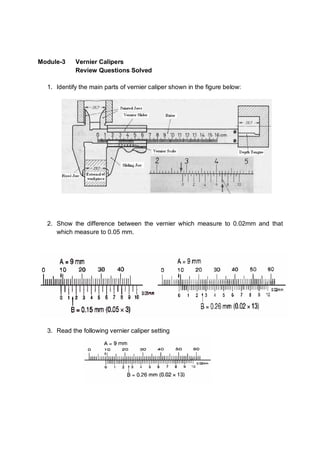
MET 102 Module 3 review-questions_solved
- 1. Module-3 Vernier Calipers Review Questions Solved 1. Identify the main parts of vernier caliper shown in the figure below: 2. Show the difference between the vernier which measure to 0.02mm and that which measure to 0.05 mm. 3. Read the following vernier caliper setting
- 2. 4. Show with sketch the principle of the vernier dial calipers. Operation of Mechanical Indicators (1) Contact Workpiece (2) Produce Motion (3) Transmit Motion Through Gears (4) Show Display on Scale. 5. State the functions of the dial calipers. - Dial calipers, and other similar measurement units such as digital and electronic direct- read calipers typically offer a - four functions capacity for taking physical measurement: o inside readings, o outside measurements, o depth assessment, and o a step-function measurement capability. 6. List the different procedures of using the gear tooth vernier caliper. a- Measure the chordal thickness of gear tooth b- To measure the gear root diameter
- 3. 7. How can calipers be used for measuring the gear root diameter. Where the gear bore size is known, a knife edge vernier can be used to measure the distance from the wall of the bore to the root of the gear. 8. Describe the features and uses of height gauge. 9. Sketch the various components of a scriber point attachment. 10. State the steps of using a vernier depth gauge. I. The base or anvil is rested on or against a reference, II. Surface and the scaled beam or tongue is pushed beyond the base to contact with the measured point. III. Readings taken at the vernier attachment show directly the length of beam or tongue protruding beyond the base.
- 4. 11. State the precautions of using the vernier depth gauge. I. Clean instrument before use and ensure sliding members move freely. II. Do not use undue pressure as inaccuracies caused by the springing of the jaws can occur. III. Parallelism of the jaws can be checked by holding the jaws together under very light pressure and viewing the gap, if any, against a light source. IV. For internal work, the nibs should be examined for wear, and a micrometer used to check the allowance to be made for the nibs, or the accuracy of the “internal” scale, if filled. V. Screws for the adjustment of the vernier scales and for the adjustment of the clearance of the sliding member are usually provided. When any adjustment is required return the instrument to the appropriate department. 12. State the reasons and effects of using the following measuring faults.
